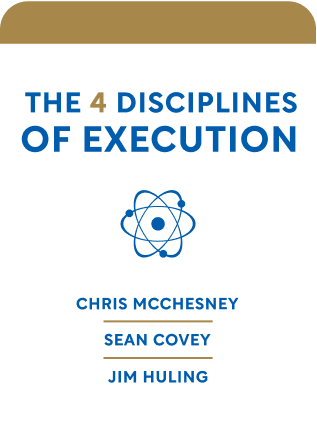

This article is an excerpt from the Shortform book guide to "The 4 Disciplines of Execution" by Chris McChesney, Sean Covey, and Jim Huling. Shortform has the world's best summaries and analyses of books you should be reading.
Like this article? Sign up for a free trial here .
Do you want to know how 4DX goals lead to behavior change? How do these behavior changes help you accomplish more?
The five-stage process for how 4DX goals lead to behavior change goes from an initial commitment to intrinsic behaviors. It takes time and dedication, but it is worth the effort.
Read on to better understand how 4DX goals lead to behavior change.
How 4DX Goals Lead to Behavior Changes
There are five stages that show how 4DX goals lead to behavior change:
Stage 1: All aboard
With the help of your team, complete the following to-dos:
- Choose the WIG.
- Choose the lead measures.
- Create a scoreboard.
- Ask everyone to reserve a time for the weekly WIG session.
Shortform Example: Tamar leads a team of sailboat riggers. Her team’s WIG is to reduce the number of dropped items by 10% by the end May. Her team’s lead measure is that each team member must make sure 100% of their tools are tied to their harness before climbing aloft. Everyone agrees to meet Monday mornings at 7 a.m.
Stage 2: Go time
Announce the start of 4DX with a meeting or huddle. As the leader, you have to be very involved at this stage and have some specific to-dos if you are committed to seeing how 4DX goals lead to behavior change:
- Remember that the launch is hard. It’ll take focus and energy, especially from the leader.
- Keep following the 4DX processes, even if initially, things are rough.
- Assess how everyone is reacting to the implementation and manage resistance. Some people will embrace 4DX more willingly than others and there are three categories:
- Models—these are your most engaged, highest performers. They immediately get on board with 4DX.
- Potentials—these people have the ability to become models, but aren’t there yet. They might lack focus, knowledge, or ability to get things done without outside pressure.
- Resisters—these people try not participate in 4DX, or think 4DX is extra, unnecessary work that won’t have any effect. To manage resisters, the first step is to figure out why they’re resisting. It may because they don’t feel listened to (in which case, hear their concerns), or because they don’t like change or new ideas, are independent, or see 4DX as extra bureaucracy. To get them on board, make 4DX about the team—they are part of a team that’s larger than themselves as an individual, and the team needs them. They’ll also be more on board once they see results.
For example, Tamar’s models were doing the 4DX processes, but she also had potentials who struggled with the change, and resisters who actively disliked it.
Stage 3: It’s working
Team members get on board with the 4DX process and change their behavior. That’s when you’ll start to see how 4DX goals lead to behavior change. As people start to see results from 4DX, they’ll become less resistant and more enthusiastic about the process, and they’ll become accountable.
It will take time to get to this stage, and you’ll spend a while plateauing here. To make sure you progress further, here are some to-dos:
- At first, don’t worry about seeing results, just focus on achieving your lead measures.
- In the WIG sessions, strictly follow the agenda—make commitments and be accountable for them.
- Use the scoreboard.
- Adjust things if you need to.
- Give the early adopters extra training and mentoring.
- Be direct and honest with the resisters and help them if needed.
For example, after a while, Tamar’s team figured out the new routine and dropped objects decreased. As Tamar’s team saw that they were improving the lead measure, they became more excited about the process. The resisters were less resistant.
Stage 4: It’s working even better
The team starts actively contributing to improving 4DX and brainstorming performance improvements. They’ve seen results and now they’re more engaged.
To take advantage of this stage, there are some to-dos for the leader specifically:
- Be open to creative ideas for improving the lead measures (though not all of them may be appropriate).
- Celebrate successes.
- Encourage everyone to help each other.
- Note when the potential’s performance starts to get close to the models’.
For example, Tamar’s team followed the 4DX disciplines for eight weeks and their percentage of dropped items decreased, but not quickly enough to meet the WIG. Tamar was out of ideas, but when she brought up the problem in the WIG meeting, her team members had ideas, such as using particular knots for particular types of tools.
Stage 5: Second nature
At this point, your team should have achieved the WIG, and as a result, the behaviors it took to get there are now a habit. Everyone’s performance has improved and your team will have a better starting point for the next WIG. This five-step process is how 4DX goals lead to behavior change.
To-dos:
- Celebrate achieving the WIG.
- Immediately choose a new WIG.
- Emphasize that the 4DX process is now the new behavioral standard.
- Help the middle achievers become top performers.
For example, Tamar’s team achieved their WIG and the behavioral changes that 4DX forced were now habits—now part of the whirlwind. They had a pizza party to celebrate and chose a new WIG.

———End of Preview———
Like what you just read? Read the rest of the world's best book summary and analysis of Chris McChesney, Sean Covey, and Jim Huling's "The 4 Disciplines of Execution" at Shortform .
Here's what you'll find in our full The 4 Disciplines of Execution summary :
- The 4 disciplines that can make any strategy a successful reality
- Why a great plan falls apart when you don't think adequately about execution
- The 6 steps you need to scale the 4DX model across an entire organization






